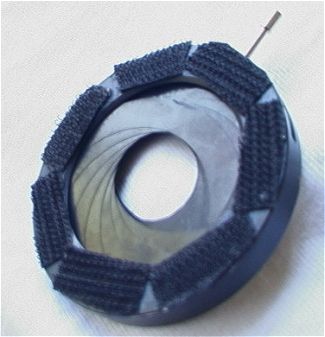The XL1 Watchdog
|
> top of page < |
Make a Protective Iris for your EVF
an article by David Brugman
The problem I found with the Optex Concertina Shutter Eyepiece made to protect the XL1 viewfinder against sunlight damage is that it required eye pressure on the eyepiece which would usually cause the image to shake; especially when using the 1.6X or a telephoto lens. I also found the concertina eyepiece to be not as comfortable as the standard eyepiece, and changing back and forth between the two is not practical on a shoot.
I came up with a very simple solution to protecting the XL1 viewfinder from direct sunlight at just one-third of the cost. It involves using an adjustable "iris diaphragm" that can be secured to the eyecup of the eyepiece with Velcro. The diaphragm works like a camera aperture and has a lever that allows you to close off all light to the eyepiece. The best thing about this method of protection is that you don't have to always have your eye pressed on the eyecup to see through the viewfinder... yet with a flick of a lever, you can close off all outside light from entering the viewfinder. In addition, the diaphragm can be taken on and off in a matter of seconds, or it can be left on without altering the function or form of the standard eyepiece The cost is very reasonable, just $56 plus a few strips of Velcro.
The part you will need to order is called a "Zero Aperture Series - Iris Diaphragm." It can be ordered from Edmund Industrial Optics (tel. 1-800-363-1992) part stock # K53-908. It has an outside diameter of 54mm (2 1/8 inches) and an full-open aperture diameter of 37mm (1 1/2 inches). The thickness is 7.2mm (5/16 inch) and it weighs about 2 ounces.
To mount it to the eyepiece cup, just attach pieces of Velcro (hook side) around on side of diaphragm and then attach similar pieces of Velcro (loop side) around the edge of the opening in the eyepiece cup. Surprisingly, the Velcro provides a very secure attachment. The viewfinder is still very comfortable to use with the diaphragm attached (use chamois eyepiece covers for extra comfort). The diaphragm can be stored neatly in a filter case, or just left on the camera at all times.
Please feel free to email me if you have any questions or comments and good luck on all your video projects.
Cheers, David Brugman at david_brugman@yahoo.com
Back to the XL1 Articles Menu
Thrown together by Chris Hurd
Please direct questions to the DV Info Net Community Forums.
Where to Buy: These dealers are authorized DV Info Net sponsors... | |||
|
|
|
|
|
|
|
|
Please support this site by making your purchases through them. Thanks! | |||
©1998-2008 DV Info Net
The Digital Video Information Network
San Marcos, Texas
Time is a great teacher, but unfortunately it kills all its pupils.


